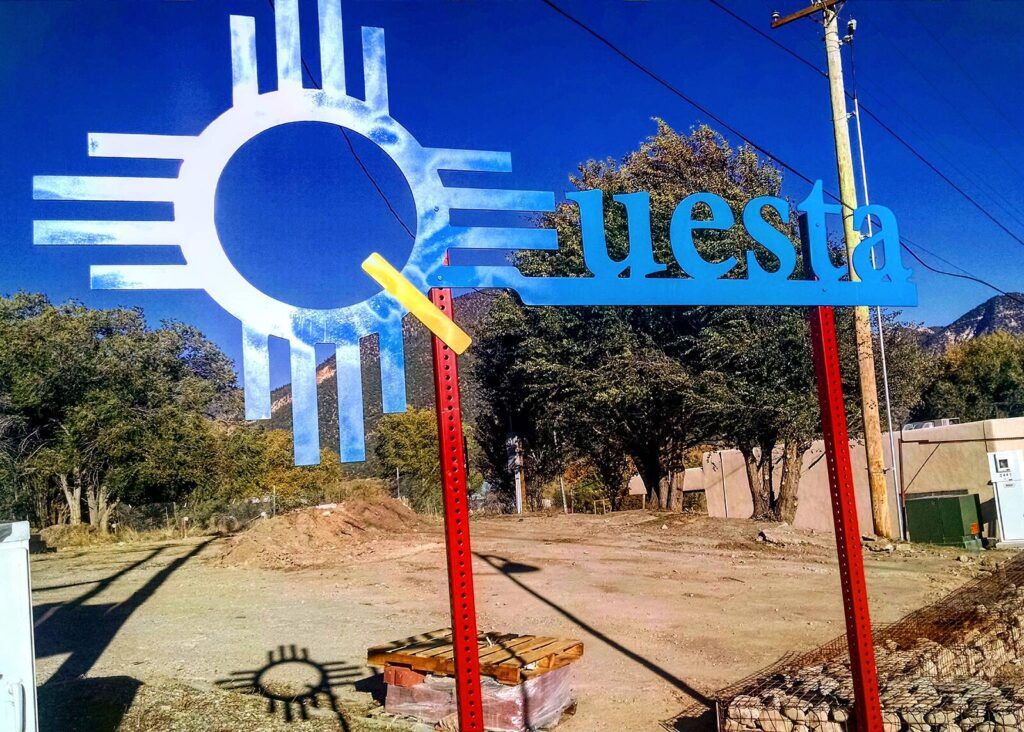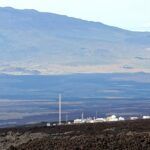New Mexico utility wants to invest in green hydrogen, but locals aren’t sold—yet
By Mary Catherine O’Connor | August 26, 2024
 Kit Carson Electric Cooperative, the utility that serves Questa, Taos and other municipalities across three New Mexico counties and two pueblos, is hoping to build a green hydrogen plant in Questa to store renewable energy as it works toward completely eliminating fossil fuels from its energy grid. (Photo: EFreiboth/Wikipedia)
Kit Carson Electric Cooperative, the utility that serves Questa, Taos and other municipalities across three New Mexico counties and two pueblos, is hoping to build a green hydrogen plant in Questa to store renewable energy as it works toward completely eliminating fossil fuels from its energy grid. (Photo: EFreiboth/Wikipedia)
Editor’s note: This story was originally published by High Country News. It appears here as part of the Climate Desk collaboration.
Hydrogen — the smallest and simplest molecule and also the Earth’s most abundant element — is essential to living things. It’s also necessary for modern industrial processes like oil refining and fertilizer production. And in Questa, New Mexico, it could help power a fossil-free electric grid by producing what’s called “green hydrogen.”
To make green hydrogen, a device called an electrolyzer splits water into its constituent parts, hydrogen and oxygen, releasing the oxygen. Then the captured hydrogen can be used in a device called a fuel cell, which can power vehicles or generate electricity. Kit Carson Electric Cooperative, the utility that serves Questa, Taos and other municipalities across three New Mexico counties and two pueblos, is hoping to build a green hydrogen plant in Questa to store renewable energy as it works toward completely eliminating fossil fuels from its energy grid. The utility is already using 100% renewables during the day, but it still relies on fossil fuels for energy at night.
In 2022, the Department of Energy named Questa one of the pilot communities for its Communities Local Energy Action Program, which supports low-income and energy-burdened communities that are shifting away from a fossil-fuel-based economy. Since then, Kit Carson Electric has been seeking funding for a green hydrogen project at a Chevron-owned molybdenum mine that is currently a Superfund site. The project would bring back a handful of the 300 permanent jobs that were lost when the mine closed in 2014. Questa’s mayor, John Ortega, thinks the technology could provide other economic opportunities as well, attracting eco-minded businesses while making Questa a trailblazer in green hydrogen and long-duration energy storage. But first, the project — and the larger green hydrogen economy — needs to overcome funding challenges, as well as the skepticism of many in the local communities.
As part of Questa’s participation in the Local Energy Action Program, the National Renewable Energy Laboratory (NREL) conducted a feasibility study for developing the green hydrogen plant and shared the study results at public meetings last August. NREL’s report indicated that the green hydrogen project could provide about 3% of the utility’s total energy needs while offsetting carbon emissions equivalent to a year’s worth of driving about 110 cars. The project would cost around $44.5 million, but after government incentives, it would increase ratepayer bills by less than $4 per month.
Some locals who attended the public meetings were less concerned about the cost than they were about the water needed for the plant. NREL estimates that the hydrogen plant would annually consume as much water as around 25 New Mexico households. “I can live without power at night, but I can’t live without water!” one local declared at a meeting.
Kit Carson CEO Luis Reyes pointed out that the amount of water coal plants use to power Questa’s homes in the evening is still five times higher than that of green hydrogen. But he concedes that Questa residents have a reason to feel protective of their water, given the ongoing drought and the legacy of water pollution from the mine. Mayor Ortega agrees; his father worked at the mine for 34 years. “The people have seen firsthand what can happen to the environment,” he said. At the same time, as he said at a public meeting about the proposal, Ortega fears Questa could become a ghost town if it does not develop a sustainable economy.
Chevron, which has funneled more than $8 million toward Questa’s revitalization efforts since 2008 through the Questa Economic Development Fund, has said it may be willing to use some of its water rights, which are currently going to the Superfund cleanup, to power the hydrogen plant.
Rachel Conn, deputy director of the Taos-based river conservancy Amigos Bravos, called the proposal intriguing and thinks green hydrogen could prove a sustainable energy solution, as long as it’s the best use for water resources. But, she added, this is New Mexico, and there are always “overarching concerns about using water for energy.”
Members of Renewable Taos, which advocates for clean energy, are cautiously optimistic about the proposal, citing its potential to store energy for a much longer duration than grid-connected lithium-ion batteries can do. But one of the group’s board members, David Munoz, a retired engineering professor at Colorado School of Mines, said he feels the technology is still too new to justify the cost; instead, he is advocating for a different energy storage solution at the old mine.
Before it can move the project forward, the utility needs to raise enough money to build the green hydrogen plant and subsidize its operation in order to avoid an electricity rate increase. Kit Carson is eyeing government incentives, rebates and funding from the USDA through the Empowering Rural America program, which supports clean energy projects in rural areas. A USDA spokesperson told High Country News that the agency planned to announce funding awards in late summer. Kit Carson received a $500,000 award this spring through the Department of Energy, but that’s a small amount compared to the $44 million price tag in NREL’s report. “It isn’t an issue of, ‘Is the funding there?’ It’s an issue of, ‘Does the federal government want to fund this type of project?’” says Reyes.
And so far, that’s unclear. Green hydrogen developers are concerned that their projects may be beat out by so-called “blue” hydrogen projects, which use natural gas to generate hydrogen, then bury the carbon dioxide emitted. While billions of federal dollars are available for funding hydrogen projects, that money is “color-agnostic” — meaning companies can receive subsidies whether they are using green or blue hydrogen. But blue can be cheaper to generate, and the U.S. Treasury Department is finalizing rules on hydrogen production that some green hydrogen advocates say could make their projects too expensive to compete.
A coalition of environmental and Indigenous rights groups in New Mexico have strongly opposed blue hydrogen projects, saying they perpetuate the oil and gas industry’s interests. “Hydrogen is a false solution that will further exacerbate the climate crisis and disproportionately harm people of color, low-income communities, and Indigenous peoples,” the groups wrote in a 2023 letter to the Department of Energy.
Tessa Weiss, a senior associate with the Rocky Mountain Institute, a nonprofit that promotes the efficient use of resources, understands the skepticism about new technologies. “But I think there’s also a right to be skeptical of existing systems that are in place and really being aware of what are those negative impacts that they’re causing our communities,” she said. Hydrogen projects “offer ways to revitalize some of the communities that have been … hindered most by the high emissions and local air quality concerns” that past industrial processes have wrought. For towns built by polluting industries like steel-making, using clean hydrogen in place of fossil energy offers a way to sustain a crucial part of the economy — as well as local jobs — while also improving public health, she said.
Whether green hydrogen can enable Questa to transform from a company-town-cum-Superfund-site into a flagship for the clean energy transition will come down to Kit Carson Electric’s ability to secure the funding and water it needs to build the plant, which would not come online until roughly 2030. But there’s a third ingredient, too, which Reyes said will make or break the project: community buy-in. “I think in the end, most people are the same. We want affordable rates. We want (electricity) to be on all the time. And we want to have a say in what’s happening within our community.”

Together, we make the world safer.
The Bulletin elevates expert voices above the noise. But as an independent nonprofit organization, our operations depend on the support of readers like you. Help us continue to deliver quality journalism that holds leaders accountable. Your support of our work at any level is important. In return, we promise our coverage will be understandable, influential, vigilant, solution-oriented, and fair-minded. Together we can make a difference.
Keywords: climate policy, energy justice, energy transition, green hydrogen, new mexico, renewable energy, water use
Topics: Climate Change















